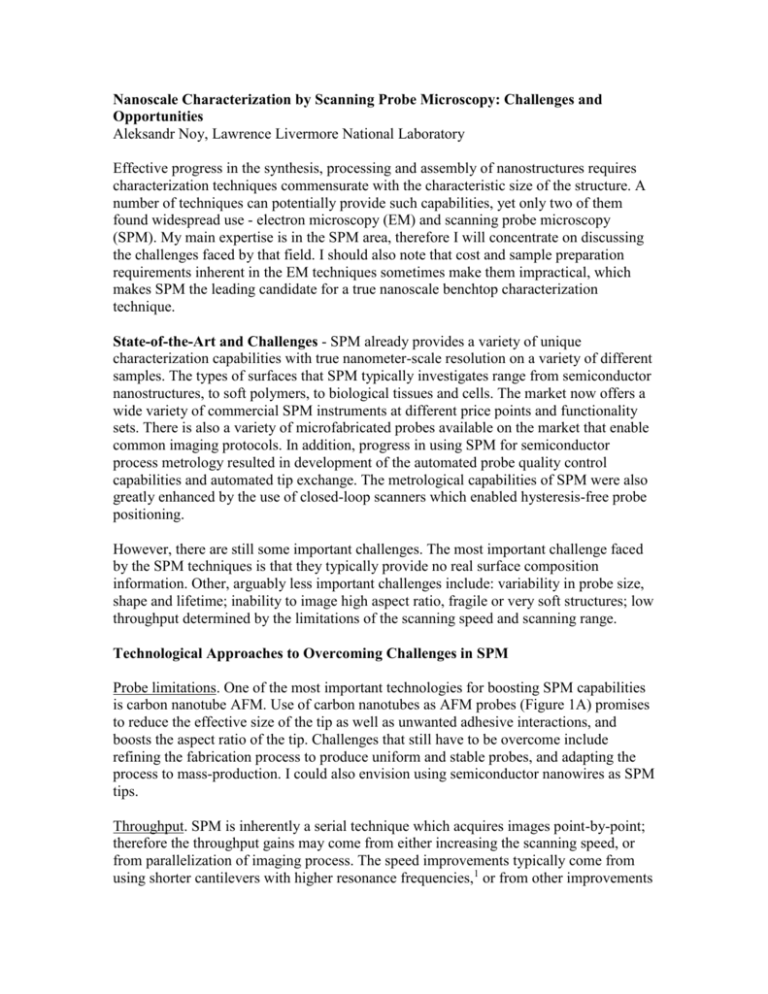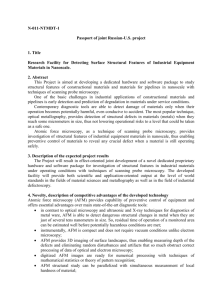Nanoscale Characterization by Scanning Probe Microscopy
advertisement

Nanoscale Characterization by Scanning Probe Microscopy: Challenges and Opportunities Aleksandr Noy, Lawrence Livermore National Laboratory Effective progress in the synthesis, processing and assembly of nanostructures requires characterization techniques commensurate with the characteristic size of the structure. A number of techniques can potentially provide such capabilities, yet only two of them found widespread use - electron microscopy (EM) and scanning probe microscopy (SPM). My main expertise is in the SPM area, therefore I will concentrate on discussing the challenges faced by that field. I should also note that cost and sample preparation requirements inherent in the EM techniques sometimes make them impractical, which makes SPM the leading candidate for a true nanoscale benchtop characterization technique. State-of-the-Art and Challenges - SPM already provides a variety of unique characterization capabilities with true nanometer-scale resolution on a variety of different samples. The types of surfaces that SPM typically investigates range from semiconductor nanostructures, to soft polymers, to biological tissues and cells. The market now offers a wide variety of commercial SPM instruments at different price points and functionality sets. There is also a variety of microfabricated probes available on the market that enable common imaging protocols. In addition, progress in using SPM for semiconductor process metrology resulted in development of the automated probe quality control capabilities and automated tip exchange. The metrological capabilities of SPM were also greatly enhanced by the use of closed-loop scanners which enabled hysteresis-free probe positioning. However, there are still some important challenges. The most important challenge faced by the SPM techniques is that they typically provide no real surface composition information. Other, arguably less important challenges include: variability in probe size, shape and lifetime; inability to image high aspect ratio, fragile or very soft structures; low throughput determined by the limitations of the scanning speed and scanning range. Technological Approaches to Overcoming Challenges in SPM Probe limitations. One of the most important technologies for boosting SPM capabilities is carbon nanotube AFM. Use of carbon nanotubes as AFM probes (Figure 1A) promises to reduce the effective size of the tip as well as unwanted adhesive interactions, and boosts the aspect ratio of the tip. Challenges that still have to be overcome include refining the fabrication process to produce uniform and stable probes, and adapting the process to mass-production. I could also envision using semiconductor nanowires as SPM tips. Throughput. SPM is inherently a serial technique which acquires images point-by-point; therefore the throughput gains may come from either increasing the scanning speed, or from parallelization of imaging process. The speed improvements typically come from using shorter cantilevers with higher resonance frequencies,1 or from other improvements in the AFM bandwidth.2 Another promising approach involves using parallel cantilevers which scan different parts of the surface at the same time. Chemical composition. One approach for obtaining surface composition information is based on controlling and monitoring the probe-sample interactions. Lieber and coworkers developed chemical force microscopy technique in which the AFM probe is modified with distinct functional groups. They demonstrated that chemically-modified AFM probes can reliably distinguish between hydrophobic and hydrophilic samples, monitor local pH changes, and provide quantitative estimates of local surface energies.3 They have also showed that chemical modification strategy can be combined with carbon nanotube AFM tip technology, which can potentially produce the “ultimate AFM probe”.4 Researchers also developed a number of approaches that use energy dissipation due to probe-sample interactions to map surface composition.5,6 The leading challenge that still remain for CFM is developing of more robust chemical coatings and developing modifications that will enhance chemical discrimination. Figure 1. A. TEM micrograph of a carbon nanotube AFM tip. B. Force vs. distance profile for interactions of two virus particles. Another set of approaches tries to couple SPM with other techniques that typically excel at chemical discrimination. The chief candidate for such technique is optical spectroscopy. Near-Field Scanning Optical Microscopy (NSOM) was the first example of such technique;7 however NSOM suffers from using a single probe to collect topographical and optical information. As the result, high spatial resolution hurts optical throughput. Another approach combines AFM with optical techniques such as confocal microscopy.8 In this approach both techniques use their respective strengths: AFM provides topography and confocal microscopy provides singlemolecule level optical signature identification. However, this approach may not resolve optical signatures of the surface features that are located within the diffraction limit. Another very promising approach combines APM with surface-enhanced Raman spectroscopy (SERS). Researchers have proposed placing Raman-enhancing nanoparticles on the SPM probe.9 Such probes have the potential to provide localized chemical identification of surface features based on Raman signatures. Xie and co-workers proposed use of local field enhancement by an SPM probe to improve resolution of the fluorescence imaging techniques.10 Nanoscale Interaction Force Measurements - Characterization of the interactions between nanostructures is at least as important as characterization of their surface morphology and chemical composition. Scanning probe microscopy has already been very successful in measuring these interaction forces on truly microscopic scale (Figure 1B).3 However, several important challenges still remain. A short-term problem is posed by the lack of robust and accurate methods for calibration of the force measurements: standard calibration techniques always produce about 10% error. Perhaps, the first step for measurement standardization could be the establishment of a common molecular scale force standard for probe calibration (perhaps even based on a biological system; one possibility is to use the stretching transition that occurs in DNA). In the longer term, we still need to push the force resolution of the cantilever systems down into the single picoNewton regime, all while maintaining adequate cantilever stiffness to avoid jumps. Drastic reductions in the instrument noise level and use of shorter cantilevers should drive progress in that area. We will also need to expand the AFM to probe different loading rates and regimes. Interaction force measurements often require large statistics; therefore the throughput issues are very important. Most of the throughput increase approaches are similar to the strategies that I have already discussed for imaging. Finally, as a long-term challenge, I should mention the possibility of using SPM for direct mapping of full energy landscapes (perhaps based on using thermal-noise assisted probing). Such capability should then open up a way for a truly rational design of nanoscale assemblies. 1 M. B. Viani et al., Review of Scientific Instruments 70, 4300 (1999). T. Sulchek, G. G. Yaralioglu, C. F. Quate, S. C. Minne, Review of Scientific Instruments 73, 2928 (2002). 3 A. Noy, D. V. Vezenov, C. M. Lieber, Annual Review of Materials Science 27, 381 (1997). 4 S. S. Wong, E. Joselevich, A. T. Woolley, C. L. Cheung, C. M. Lieber, Nature 394, 52 (1998). 5 J. Cleveland, B. Anczykowski, A. Schmidt, V. Elings, Appl. Phys. Lett. 72, 2613 (1997). 6 A. Noy, C. H. Sanders, D. V. Vezenov, S. S. Wong, C. M. Lieber, Langmuir 14, 1508 (Mar 31, 1998). 7 R. C. Dunn, Chemical Reviews 99, 2891 (1999). 8 A. Noy, T. R. Huser, Review of Scientific Instruments 74, 1217 (Mar, 2003). 9 S. A. Vickery, R. C. Dunn, Biophysical Journal 76, 1812 (1999). 10 E. J. Sanchez, L. Novotny, X. Sunney Xie, Physical Review Letters 82, 4014 (1999). 2







